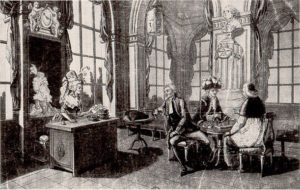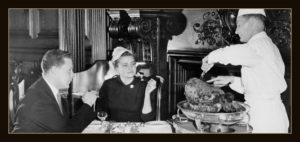
Have you been out to dinner at a nice restaurant lately? When you told your friends, did they look at you with pity and then gossip about you behind your back? Is your reputation ruined? How times change, LOL!
The fact is, during the Regency in England, dining out as a social event the way we know it was not done. The very concept of the modern restaurant was still in its infancy –it evolved in France (of course?) in the later 18th century and had not successfully caught on yet in England. But there was a glimmer on the horizon, and a few eating establishments were heading in the right direction. (I’ll come back to these near the end.)
People did “eat out”, of course. You could obtain a meal in a tavern, pub, or an inn or a fine hotel, particularly if you were traveling. You could purchase specific foodstuffs from street vendors, but that wasn’t a “meal.” And any of these were, in general, patronized out of necessity or convenience, not for pleasure. There were no menus offering choices –only perhaps, a list of what was to be served. Generally only the simplest inexpensive meats and vegetables were served, except for a few taverns that catered to a specific well-heeled (male) clientele.
If you were an upper-class male, you could enjoy a meal at your private club. The food offerings might be somewhat more elegant, but would still be limited. You ate what they served, at the time they served it. Men could also patronize the coffee and oyster houses, which often served other food in addition to their main focus. For females to dine in public was quite shocking, however, unless in a coaching inn, and if you were of the upper class, you would still insist on a private parlor.
Part of the stigma, of course, came from the fact that acceptable households employed their own cooks. Why would you prefer to eat out when you could eat in? “Dining out” socially meant going to dinner at someone else’s private home, eating food prepared by their cook instead of yours.
Another part of the stigma was the idea of rubbing elbows with the hoi polloi –the general public. Not done! People forced to “eat out” were the poor who had no cook, and often, no kitchen at all. Taverns were noisy and crowded, with communal tables. “Even a moderately well-to-do person would have preferred to order food delivered to a private home or a room at an inn or hotel or an elegant salon rented for the occasion…” (1)
No wonder your friends viewed you with pity! What calamity caused you to need to eat out? And if you were female in mixed company, oh, dear. Shocking!
These social aspects of dining out offer a clue to why the modern restaurant was born in France (and why England resisted). The French Revolution brought in sweeping social changes that coincided with some new developments. “Restaurant” originally meant a type of meat soup, like consommé or bouillion, used medicinally as a “restorative”. In 1765 a bouillion-seller had opened a shop with tables where ailing customers could sit and eat their soup. Different customers required different types of restoratives, so the idea of individual customized servings was introduced. Others copied the idea. In the early 1780’s a man named Beauvilliers, the former chef of the Count of Provence, carried the conceit further and opened the first real restaurant with small individual tables and a menu listing individual choices with prices.
In 1786 he opened the first “luxury” restaurant in the Palais Royale, featuring mahogany tables with white tablecloths, trained waiters, chandeliers, a wine list and an extensive menu of fine food choices. That same year, the Provost of Paris issued a proclamation officially recognizing and authorizing these new types of establishments. These developments paired with a ready supply of cooks and servants no longer employed by the artistocracy, the dissolution of the guilds that had restricted how and by whom food could be prepared, and a customer base of displaced provincials without families in Paris, journalists and businessmen, a newly important middle class. Two different principles were suddenly wedded in a successful new way to do business –the personal tastes, budget and choices of the individual now controlled the purchase of a meal, while the egalitarian social climate celebrated that “Eating [well] was no longer the privilege of the wealthy who could afford to maintain a cook and a well-supplied kitchen.” (2)
 Within ten years there were more than half a dozen restaurants in Paris, and “dining out” was accepted practice there enough to provide the basis for a political cartoon about the 3rd Estate in France (above), entitled “Separate cheques please”:
Within ten years there were more than half a dozen restaurants in Paris, and “dining out” was accepted practice there enough to provide the basis for a political cartoon about the 3rd Estate in France (above), entitled “Separate cheques please”:
Meanwhile, back in London, the oldest still-surviving restaurant in London, Rules, was started in 1798, on Maiden Lane in Covent Garden. Although at first it was simply an oyster bar, as their website states: “Contemporary writers were soon singing the praises of Rules’ “porter, pies and oysters”, and remarking on the “rakes, dandies and superior intelligence’s who comprise its clientele”.
Two other London establishments might challenge the “oldest” claim by Rules, but one (Wilton’s, opened 1742 as a seafood street stall, 1805 as an oyster room) has changed locations and nature many times, while the other (Simpson’s Tavern) is more of a pub, and ancient pubs are not rare anywhere in England! Note ladies were not admitted to Simpson’s Tavern until 1916.
Simpson’s-in-the-Strand (not related) was founded in 1828 primarily as a chess club/coffee house/smoking room (“The Grand Cigar Divan”). They are still famous for serving meats at tableside from antique, silver-domed carving trolleys, a practice said to have evolved to avoid interrupting the play during chess games. 
You can see these were not yet exactly “restaurants” in the Parisian sense at the time they opened their doors. The modern form of “dining out” really didn’t take hold in Britain until the mid-Victorian era, when the swelling ranks of the new middle class provided an enthusiastic customer base for it.
Have you written or read characters who needed to dine out for one reason or another? Are you surprised to know what a big difference existed between customs in Paris and London during this time period? Have you ever eaten at any of the London restaurants mentioned, or have a favorite restaurant there to share?
Sources quoted:
(1) “The Rise of the Restaurant,” Food: a Culinary History, Jean-Louis Flandrin & Massimo Montanari
(2) Oxford Companion to Food, Alan Davidson [Oxford University Press:Oxford] 1999)
For further reading online:
http://www.foodtimeline.org/restaurants.html#oldestmenu
https://www.mtholyoke.edu/courses/rschwart/hist255-s01/pleasure/history_restaurant.html
Also, check out:
A History of Cooks and Cooking, Michael Symons [Universtiy of Illinois Press:Urbana IL] 1998 (p. 289-293)
Save

Last week I talked about one of my favorite winter pastimes–climbing under the electric blanket and watching movies until it’s spring again. This week, my #2 winter favorite–eating! Regency-style (sort of).
I’m not much of a cook. I just don’t have the patience for it, beyond stuff like omelettes and pasta carbonara. But I love to eat (and I’m sure my hips will love me for it, come May and sundress time!). And, if you look at portraits of people like our friend Prinny, obviously people in the Regency shared my appreciation for yummy cuisine.
Regency dinner parties were quite different from my own, of course. No bagged Caesar salads and boxes from the Mandarin Wok. Louis XIV’s court at Versailles (no slouch in the dining department) established the custom of dining “a la francaise”, i.e. all the different dishes at each course were placed on the table at the same time. Diners could then help themselves (or let footmen help them) to whatever was nearby. I imagine this would mean that the guests couldn’t sample all the dishes, so you would have to be sure an interesting selection was near each guest. It would be terrible if your favorite was waaay down the table! In France, important feasts could include up to eight courses (including my favorite, dessert), and last many hours. In England, it seems that even very formal dinners were usually in three courses (also including dessert!), after which ladies could retire to the drawing room for tea and gossip, and the men could remain behind for drinking.
But even the abbreviated courses meant dinner could last hours. In 1829, in a book titled “Apician Morsels”, the author wrote, “Five hours at dinner table are a reasonable latitude when the company is numerous and no lack of good cheer.” In “The Experienced English Housekeeper” (1769), Elizabeth Raffald pointed out “As many dishes as you have in one course, so many baskets or plates your dessert must have, and as my bill of fare is twenty-five to each course, so must your dessert be of the same number and set out in the same number.” Thus making 75 dishes. At a party in 1767, Sir William Lowther offered 180 dishes at his home in York.
The first course usually consisted of soups and stews, vegetables and boiled fish and meats, followed by “remove” dishes of more fish or meat. The second course sounds similar to me–vegetables, meats, fish, with exotic pies and other savory baked fare like “gumballs” and “cheese wigs.” (FYI, gumballs were made from eggs, flour, sugar, butter, mace, aniseed, and caraway seeds mixed together in a paste, then baked. Cheese wigs–er, I’m not entirely sure. Maybe another Risky can enlighten us!). Dessert was then the crowning glory. In 1750, Horace Walpole wrote “All the geniuses of the age are employed in designing new plans for dessert.” At a party given by the Duke and Duchess of Norfolk in 1756, dessert was “a Beautiful Park, round the edge was a Plantation of Flowering Shrubs, and in the middle a Fine piece of water with Dolphins Spouting out water.” Beats a carton of Hagen Dazs Dulce de Leche, I guess. 🙂
A very large household could employ their own confectioner, but smaller households would usually make use of independent chefs. In 1763, Viscount Fairfax held a party for 18 people, and the invoice for dessert (provided by William Baker) was 16 pounds, which included the rental of the glass structures necessary to display the dessert.
I recently came across a slightly modified recipe for Hedgehog Cake, which I may (or may not) attempt soon. Cake and custard, ummmmm. (If you’d like the recipe, just let me know!)
Hopefully winter will be over soon!